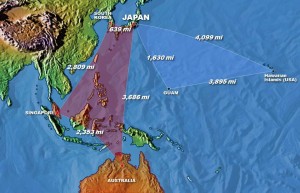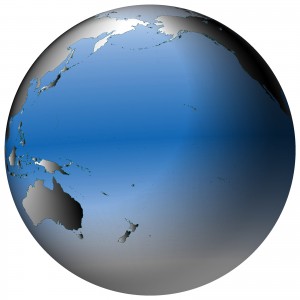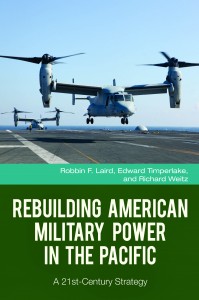2013-10-30 By Robbin Laird, Ed Timperlake and Richard Weitz
We have just published our new book on shaping a 21st century strategy for Pacific defense.
The book examines the challenge of re-shaping U.S. forces to deal with 21st century strategic realities for Pacific defense.
It is often stated that the 21st century will be the Pacific century.
This assertion is based on an expectation about the continued economic growth in Asia and the global impacts of the impact of such growth on global capabilities. Among these global capabilities are military means and security challenges.
While one might challenge any simplistic projection of straightforward growth from China and others in the region, clearly the Pacific is a region of growing global impact and significance.
It is also a region, which since the end of World War II has seen a central role of the United States in providing key support for the security of many players in the region, and has been the region where the US has fought two major wars.
But this historical benchmark role for the United States as underwriting the defense and security of many key allies in the region is under pressure. The United States has been involved in land wars in the Middle East and beyond, and as well as faces significant financial pressures. Investments have been made in equipment and manpower to fight the land wars at the expense of investing in the needed power projection capabilities appropriate to the Pacific.
At the center of the changing dynamic has been the rise of the People’s Republic of China. The growth of the Chinese economy and the global reach of that economy have been fundamental drivers of change. And with this economic power has come increasing aspirations to shape military and political clout seen as appropriate to the Chinese position globally.
For all the key players in the Pacific, China has become the key trading and economic partner and, at the same time, the most salient military and security threat. Dealing with both issues is at the heart of meeting the Chinese challenge to Pacific security.
But properly characterizing the challenge and calibrating the response is a major task.
The book is designed in part to meet this task.
- What are the evolving challenges towards which those capabilities need to evolve?
- What kinds of policies will allies follow and what kinds of capabilities will they generate?
- How best to coordinate and combine U.S. and allied capabilities to deal with the various challenges in the Pacific?
With regard to China, a global shift in manufacturing capability towards China, a significant investment by China in global commodities and the enhanced presence of China on the world stage are all significant developments. When married to a growing investment in the development and fielding of military capabilities, something globally significant is afoot; a change of the sort which suggests changing epochs.
This all raises the question of what template or templates we should use to interpret the ascendant Chinese military challenge?
Many analysts simply compare or contrast the state of Chinese military power to that of the United States. This is seriously flawed because the U.S. built a power projection capability to deal with the Soviet Union and Asian operations, and the sunk cost in this investment still provides for unparalleled global capabilities.
But sunk cost is not the same as making significant investments in building relevant capabilities. China does not need to mimic or match U.S. power projection capabilities to become ascendant. They need simply to project power into the Asian region and to reshift the power relationships within Asia.
The U.S. has been the key lynchpin holding together the Asian powers, which de facto, contain or constrain China. An ability to threaten the lynchpin function is almost enough by itself to create the effect which the Chinese leadership would wish to create – Asian powers competing with one another without the binding power of the American lynchpin. This leaves them open to Chinese hard power being married to the ascendant soft power of China in the region.
The capabilities, which the Chinese are emphasizing – notably air and missile systems – are eminently exportable.
By having a first class missile business a decade out, the Chinese can change regional power balances by an export policy supported by the power projection capability necessary to dominate in far away regions.
Also, the Chinese are enhancing their Coast Guard capabilities to shape their role in securing the conveyer belt of goods and services. They have entered the world in the fight against piracy and are participating with Coast Guard or Navy ships and assets far away from Chinese waters.

Additionally, the tool sets of no interest for Western or U.S. forces to acquire, such as mini submarines, are of interest to the Chinese. They have a distinct interest to invest in “asymmetric” technologies to shape disruptive capabilities to U.S. and allied forces.
The largest Coast Guard fleet in Asia belongs to Japan, but the Chinese are expanding their fleet. Americans often forget the significance of global USCG activities and with the USN entering into some traditional domains operated by the USCG with its littoral assets, the role of Coast Guard activities as part of the global presence activity will grow in significance.
This is especially due to the role of global maritime trade, the need to protect the “conveyer belt of goods” and the expanded significance of offshore minerals and commodities. Presence is a key good for power projection in the 21st century, even if this presence is playing “civil” functions.
In other words, the Chinese can invest in technologies for global export, for enhanced “asymmetric” capabilities, and anti-access denial and it is enough to degrade declining numbers of U.S. forces.
But the Chinese challenge is not the only one defining the scope and nature of the Pacific defense and security effort appropriate to the 21st century.
A second key challenge is that posed by North Korea.
North Korean nuclear and missile capabilities are part of what Paul Bracken calls the Second Nuclear Age.
The defense of South Korea remains a legacy of the unfinished Korean War.
What is different now is that North Korea is shaping significant nuclear capabilities and evolving the delivery means. And more generally, the nuclear dimension is neglected in U.S. thinking about the future of defense in the Pacific, but certainly not in the minds of the key national players in the Pacific.
We did an interview with Bracken, which highlights some core aspects of how to understand the evolving nuclear challenge.
According to Bracken:
In the first nuclear age it was learning by crisis, and we got fortunate because the crises that started were not particularly severe. If the Cuban Missile Crisis had come in the late ’40s, God only knows what would’ve happen.
Nonetheless, I think we need to prepare for a crisis exploitation which crystallizes the issues we’re talking about, much as 9/11 did. Many people prior to 9/11 were talking about, terrorism, counterterrorism, but nobody paid any attention to them.
The early Bush administration in 2000 was dismissive because they had other fish to fry and then 9/11 happens and the existence of prior thinking on counter terrorism was rapidly exploited.
The kind of crisis in which learning might occur could revolve around something like the Pacific islands in dispute in the South China Sea.
If there’s a major Chinese move against one of these islands, the Japanese and U.S. forces will be forced to respond.
But what if the Chinese start moving some nuclear weapons around? What do we do then?
That’s really a distinct possibility. But I cannot find anybody in the U.S. government who really thinks about the realism of such a situation like that.
The Pacific is already a big place in which to move forces to provide for the defense of the United States and its core allies.
The reality of what is called the “tyranny of distance” is significant but the problem is becoming worse with the addition of the Arctic due to melting ice to the Pacific agenda. The Arctic sitting at the top of the world bridges multiple worlds, but as the ice melts, new transportation routes open, and with them access to significant resources located in the region.
The Arctic must be added to any realistic examination of the challenge of building an effective Pacific strategy for the 21st century.
Not only will the Chinese leverage transit routes to “break out” of the Pacific, but also the Russians over time will be able to integrate their European and Pacific forces to provide for more effective leverage from the top of the world.
A final key element is the evolving nature of the security challenges in the region.

Not only are there persistent low intensity threats throughout the region, but also the scope and nature of maritime trade in the region has seen the emergence of a “conveyer belt” of goods transiting from Asian ports to American ports, and then goods transship over the United States for shipment out of U.S. ports as well.
Securing the “conveyer belt” is a major security challenge in and of itself, but also because maritime terrorism can be woven into the conveyer belt in ways of concern for defending core American “homeland” security.
This means that littoral defense is also a key part of meeting the challenge of the 21st century Pacific.
And as the Arctic opens to greater flows of maritime trade, it becomes part of the broader challenge of securing the “conveyer belt” so fundamental to globalization.
In short, the challenges are significant – the rise of China, the North Korean threat, the emergence of the Arctic, and the challenges associated with counter terrorism and maritime security.
At the heart of an effective response will be shaping innovative relationships between the U.S. and its allies and come to terms with ways to deflect Chinese expansion but to work with China in shaping global prosperity.
The challenge will be to forge effective building blocks through partnerships, technologies and organizational innovations which can provide a 21st century of security and defense in the Pacific.
A key element for success is training and preparation for the 21st century, not remaining in the mindset of the 20th. One USMC general referred to the need to shape new capabilities for the I-Pad generation pilots, and not for his own generation. What he had in mind was the touch screen cockpit of the F-35 and its ability to work with the visual acuity of the new generations.
It is always important to remember that the human element in military operations is a combination of the technical skill, resourcefulness and dynamic innovation by members of the fighting force combined with individual courage, training and competent leadership at all levels and often as Napoleon said he also liked having a Lucky General.
What may be overlooked because military history most often focuses on battles and wars as they were fought is the pre-hostility build up. Or in the case of our Korean War, what was not done. Overlooked in many histories is the judgment and intellectual courage of national leaders before hostilities begin on what the U.S. military should look like.
The goal of the U.S. Service Secretaries, Army, Navy and Air Force to support equip and train their respective services so our combat commanders can fight a battle ready joint force is our current system. Secretary Rumsfeld touched on this with his quote-you go to war with the Army you have.
So to put a nation’s human capital in perspective, not only does a population field a military force with it’s most precious treasure, the lives of their young men and women, but in a democracy every American using the power of their vote to allocate resources has a direct connection to a successful military campaign or a battlefield debacle in future conflict.
One easy example is the process of the U.S. Navy innovators to shift the focus of the fleet from a battleship-dominated navy to an aircraft carrier enabled fleet. Even from the get go, the Navy needed a population willing to support that endeavor, along with trained sailors and pilots who could pioneer the effort.
The evolution of the aircraft carrier occurred in peacetime with careers always at risk but more importantly pilots paying the ultimate price in accidents. Navy Admiral’s were trying to understand what it all means, and history tells us some of the early pioneers were already retired or had been killed in training when the Miracle at Midway occurred and sealed the fate of Japan.
An example of U.S. democratic political process for our Army was the fact that, after France fell to Nazi Germany, the bill for a U.S. national draft passed by one vote. It was a near thing.
America is the famous “melting pot” with many cultures supporting a military that cherishes meritocracy as a fundamental touchstone of leadership. Combine those attributes in a representative democracy with a vibrant 1st Amendment fostering robust public debates on military resources and so far we tend to get it right. However, at times the U.S. has been just plain lucky.
Korea was a textbook case of America not being prepared.
However, it was also a textbook case on yet again looking to the services to rally and get it right in a war. From Inchon to the “Frozen Chosen” breakout, the Marines did all they could and more. Mig-Ally brought the USAF into the fighting jet age with courage and success. The Fleet carrier pilots answered the call; just read The Bridges of Toko-Ri.
Vietnam yet again showed the limits of the will of the American voter when the U.S. Congress said no more money and that was that. Yet the men and woman who stayed in through the subsequent hollow years built the most impressive and technically proficient fighting force the world has seen and became evident in the air campaign building up to the U.S., UN 100 hour ground war. As the song says “the beat goes on.”
Now we have a new generation.
Will the American policy community and voters support the new generation and its transition to a 21st century strategy appropriate to the Pacific? Nothing is certain.
This book is a contribution to shaping broader understanding of what is necessary and what needs to be done, if vision and will are added to technological change.
It is designed to define the challenges and suggest paths to shaping solutions appropriate to the challenges.
It makes no sense to take 20th century thinking forward to deal with 21st century challenges and to operate within the mental furniture of the past.
The PRC push out into the Pacific and North Korean developments intersect with U.S. technologies to shape a strategic trajectory as important as the carrier was to the 20th century in the Pacific, namely shaping a distributed operations force for the U.S. and its allies. The book lays out some of the key ways to shape such a force.
Robbin Laird, Ed Timperlake and Richard Weitz, Rebuilding American Military Power in the Pacific: A 21st-Century Strategy (Praeger Publishers, October 28, 2013).
http://www.abc-clio.com/product.aspx?isbn=9781440830457
http://www.amazon.com/Rebuilding-American-Military-Power-Pacific/dp/1440830452/
Ed Timperlake and Robbin Laird will be discussing the new book at the forthcoming Air Force Association’s 2013 Pacific Air & Space Symposium in Los Angeles in November 22, 2013 as well.
http://www.afa.org/PacAirSpace/PASS2013Symposium/Agenda
We are offering the readers of Second Line of Defense a special discount on the book, if they use the following form and ordering code:
Rebuilding American Military Power Order Form


